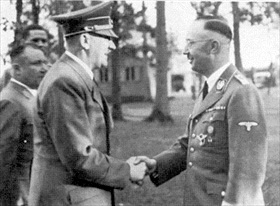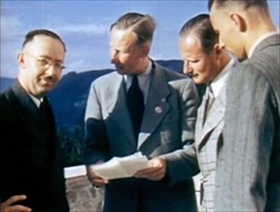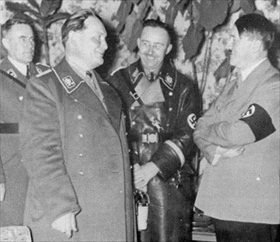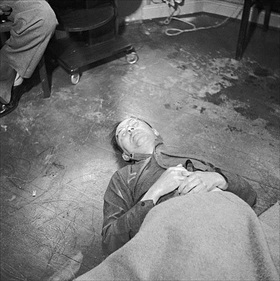HITLER DEPUTY PROPOSES SURRENDER TERMS
Luebeck, Northern Germany · April 24, 1945
Reichsfuehrer-SS, Gestapo chief, and Adolf Hitler-devotee Heinrich Himmler began making clumsy attempts to secure a separate peace treaty with the Allies as the defenders of the Reich capital—ground zero of Nazi resistance—failed to push the Red Army back across the Spree River, the last physical barrier to the Soviet conquest of Berlin. Himmler was in Berlin on April 20, 1945, to congratulate Hitler on the occasion of the Fuehrer’s 56th birthday—a somber one spent in the gray bowels of the Reich Chancellery bunker—then scampered away to Northern Germany. Meeting in the Baltic port city of Luebeck with Count Folke Bernadotte, vice-president of the Swedish Red Cross, and without his master’s knowledge, Himmler offered German capitulation on the Western Front but not on the Eastern. (Himmler misrepresented himself to Bernadotte as the provisional leader of Germany.) Bernadotte forwarded Himmler’s terms to the Allies through the Swedish Foreign Ministry. The Allies replied tersely that German capitulation could only be accepted if it embraced all fronts, and that the Allies would continue pressing their attacks until they had achieved complete victory. For Hitler, the backdoor scheming of “der treue Heinrich” (the loyal Heinrich) was the last straw, especially when it was confirmed by the British Reuters news agency and broadcast for all the world to know on April 28. To the few Nazi stalwarts still with him in the bunker Hitler ranted that Himmler’s act of treachery was the worst he had ever known. He ordered Himmler’s immediate arrest and the execution of Hermann Fegelein, Himmler’s SS representative at Fuehrer HQ Berlin. Late that night Hitler married Fegelein’s sister-in-law, Eva Braun, with whom he had a 14‑year intimate relationship. Then he dictated a political statement and last will and testament, named as his political successor Grand Admiral Karl Doenitz (in Flensburg, Northern Germany, near the Danish border), and took his life and that of Braun on April 30. Doenitz wanted nothing to do with the notorious and conniving SS chief, who now went into hiding. Captured by the British, Himmler bit down on a cyanide capsule during interrogation and died within 15 minutes. He was buried in an unmarked grave near Lueneburg, 28 miles southeast of Hamburg, in the German state of Lower Saxony.
![]()
[amazon_carousel widget_type=”ASINList” width=”600″ height=”200″ title=”Recommended Reading” market_place=”US” shuffle_products=”False” show_border=”False” asin=”019966921X,0393337618,0199592322,1848325223,1602392463,0312423926,1602391785,1591148944,0304358398,0764312022″ /]
Reichsfuehrer-SS Heinrich Himmler: The Second Power in Adolf Hitler’s Germany
 |  |
Left: Head of the SS (Schutzstaffel, the Nazi party protection squads) from 1929 to 1945 and chief of the Gestapo (secret state police) from 1934 to 1945, Himmler was second to Hitler as the most powerful man in Nazi Germany. From 1943 to 1945 Himmler held another post, Minister of the Interior; in this position, he one of the persons most directly responsible for the Holocaust.
![]()
Right: Himmler with Reinhard Heydrich (holding sheets of paper) at Hitler’s Bavarian retreat on the Obersalzberg, 1939. Heydrich, ruthless head of the Reich Security Main Office (Reichssicherheitshauptamt, or RSHA), worked under Himmler. In July 1941 Reichs Marshal Hermann Goering ordered the conscienceless and more-than-willing Heydrich to prepare the “Final Solution”—the extermination of all Jews in Europe.
 |  |
Left: On the day of the invasion of Poland, September 1, 1939, Hitler tapped Goering, here seen with Himmler, to be his successor. From 1942 onwards Goering largely withdrew from the military and political scene when the Luftwaffe, which he headed, stumbled on both the Western and Eastern fronts.
![]()
Right: Himmler’s body on the floor of British 2nd Army HQ after his suicide on May 23, 1945, during a routine interrogation. Two days earlier Himmler, a fugitive using an alias, had been detained at a British checkpoint. During his interrogation Himmler revealed his true identity.
Himmler and Hitler: The Last Days of the Third Reich
![]()

 History buffs, there is good news! The Daily Chronicles of World War II is now available as an ebook for $4.99 on Amazon.com. Containing a year’s worth of dated entries from this website, the ebook brings the story of this tumultuous era to life in a compelling, authoritative, and succinct manner. Featuring inventive navigation aids, the ebook enables readers to instantly move forward or backward by month and date to different dated entries. Simple and elegant! Click
History buffs, there is good news! The Daily Chronicles of World War II is now available as an ebook for $4.99 on Amazon.com. Containing a year’s worth of dated entries from this website, the ebook brings the story of this tumultuous era to life in a compelling, authoritative, and succinct manner. Featuring inventive navigation aids, the ebook enables readers to instantly move forward or backward by month and date to different dated entries. Simple and elegant! Click 











